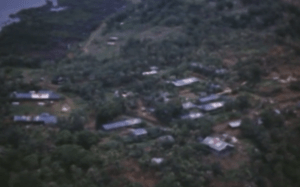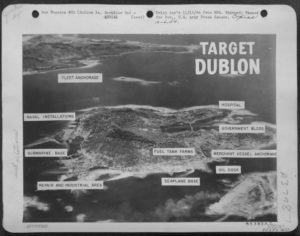As far as the Truk Incident war crimes (as outlined in the previous post) go, I now have a clear focus on what I’d like to find out – which is whether the Imperial Japanese Navy’s war crimes against American prisoners of war in Truk were accompanied (as Nick Redfern’s “Black Widow” source seems to imply) by more systematic crimes against humanity.
But where should I go looking for evidence to test this research question?
WCDI / NARA / IWG
The WCDI (War Crimes Documentation Initiative) has a nice page on War Crimes archival sources on trial records, which quickly led me to the Nazi War Crimes Interagency Working Group (better known as the “IWG”)’s NARA page on research resources on Japanese War Crimes.
I highly recommend reading the 200+ page-long Introductory Essays document linked at the top there: this contains well-written essays not only on Japanese War Crimes themselves, but also on the complicated and tangled politics surrounding them. The essay writers highlight many issues that historians have yet to make a substantial impact on, such as Japanese crimes against native Pacific populations (which even today remain significantly under-reported).
Here’s what p.81 has to say about RG 125:
The main body of records [released in 1997] produced by Navy JAG [Judge Advocate General] during its war crimes investigations is in the Records of the Navy War Crimes Branch collection, which has numerous entries with information on war crimes committed against Americans held captive by the Japanese. For example, Case Files of Pacific Area War Crimes Trials, 1944–49 has many documents pertaining to the U.S. Navy trials of 123 Japanese military personnel tried on Guam and Kwajalein between 1945 and 1949, primarily for alleged mistreatment of POWs and the unlawful executions of captured Navy airmen.
It didn’t take long to find “Case Files of Pacific Area War Crimes Trials, 1944–49” on the NARA site…
Hiroshi Iwanami’s Case File
Handily, the case file for Hiroshi Iwanami and his men (National Archives Identifier: 6997364 HMS Entry Number(s): A1 2, UD-16W 1 Creator: Department of the Navy. Office of the Judge Advocate General. Navy Division. War Crimes Office. 1/13/1945-9/18/1949) is available online. At first sight, this seems to be quite large: but then you discover that nearly all of it is a 1600-signature petition asking the court for clemency. The actual court record starts at page 192 (of 197), with three charges of murder and six charges of violations of the laws and customs of war. Here’s the first specimen murder charge:
30 Jan 1944, IWANAMI, while Commanding Officer of Fourth Naval Hospital, Dublon Island, Truk, with others, murdered six (6) American POWs, by experimenting upon them with virulent bacterial and by exposing them to shock, this in violation of the law and custom of war.
Iwanami pleaded not guilty to all charges, but was found guilty of all (bar the second murder charge, which was proved to have been Lieutenant Shinji Sakagami’s fault.) The main procedural interest in the case arose because Shigeyoshi Nakamura committed suicide after giving evidence but before being cross-examined: Iwanami’s defence asked for Nakamura’s testimony to be withdrawn (because it had not been tested in court), but it was allowed to be used as evidence.
Other NARA Files
For Japanese war crime archives, the main finding aid is surely Greg Bradsher’s 1700-page “Japanese War Crimes and Related Records: A guide to Records in the National Archives“. However, the NARA website allows you to drill down into RG (“Resource Group”) 125, to find other archival documents
The specific sections of RG 125 that seem likely to be relevant are:
- Records Regarding Pacific Area War Crimes Cases, 1945 – 1949
- Correspondence from Records Originated by the Director of War Crimes, Pacific Fleet, 1945 – 1949
- Secret Correspondence of the Director of War Crimes, Pacific Fleet, 1945 – 1949
- Card Name Index to Correspondence from Records Originated by the Director of War Crimes, Pacific Fleet, 1945 – 1949
- Confidential Correspondence Originated by the Director of War Crimes, Pacific Fleet, 1945 – 1948
- Restricted Correspondence Originated by the Director of War Crimes, Pacific Fleet, 1945 – 1949
- Memorandums, Dispatches, and Related Records Originated by Director of War Crimes, Pacific Fleet, 4/1945 – 10/1949
- War Crimes Investigations and Trials from Records Originated by Liaison Officer for War Crimes, Naval Forces Marianas, 1945 – 1949
- Records Regarding Interrogations of Japanese Witnesses and Defendants in War Crimes Cases, 1945 – 1949
- Exhibits to Investigations, 1943 – 1949
The NARA records include a number of short films, including “AERIALS OVER TRUK“, which contains a shot of a hospital complex (which I believe is on Truk rather than on Dublon Island, though I could be wrong):
The archives include a fair number of good quality photos (many taken from bombers as they were dropping bombs), including this one showing a spotter’s guide to Dublon Island, where you can see the Naval hospital at the top right:
Finally, It’s Wrapping Up Time
The bad news is that even though just about access to everything in RG 125 is marked as being unrestricted, hardly any of the files in RG 125 that I would consider interesting have yet been digitised. More broadly, the Navy hospital atrocities on Dublon Island seem to have received very little mainstream attention over the last 70+ years: it is as though interest waned to zero once the war crime trials had concluded.
Even so, there are a fair few books and articles that I can get to read that cover Dublon Island. For example, the (2010) book “Japan’s Wartime Medical Atrocities: Comparative Inquiries in Science, History, and Ethics” looks like it could be a good reference work (but at ~£40 is a bit pricey). Similarly, “The Surrender of the Fortress of Truk” (Charles Blackton, 1946) is on JSTOR, and looks like it might cover some of what I’m interested in.
All the same, other books on Dublon Island have a quite different focus. Charles Hill’s (2000) “Fix on the Rising Sun” (mentioned online here) discusses a connection with the Hawaii Clipper mystery (Joe Gervais was told that the missing plane was concreted over to form the base slab of the hospital in 1938, along with its missing airmen). But make of all that what you will.
There’s also some helpful description of the hospital on the Pacific Wrecks site here. One commenter (Dick Williams) mentioned the following there (I have no idea what book “Ghost Ships” is, if anyone knows please tell me):
“Hospital where an American aviator POW met his end. He was kept in the room at the far right. Read his account in “Ghost Ships” Silander Manuel, a Mortlockese who taught me Trukese told me about him that they also slit his eyelids so that his eyes could never close again. This just before they killed him. That’s what Richard, the orderly who went to Saipan to testify against the Japanese, told me they did with them.
Finally: care with names has to be exercised: originally Dublon Island, it was renamed Natsushima (Summer) Island by the Japanese, its codeword to the Americans in WWII was ADHERENT, but is now called Tono[w]as Island in Chuuk State, Federated States of Micronesia.
Postscript: The Trial Transcript
Having posted all the above, I finally stumbled upon the trial transcript online here, which I’ll be going through next…


With all this Japanese stuff, I feel the urge to watch Nagisa Oshima’s “Furyo”/”Merry Christmas Mr. Lawrence” again.